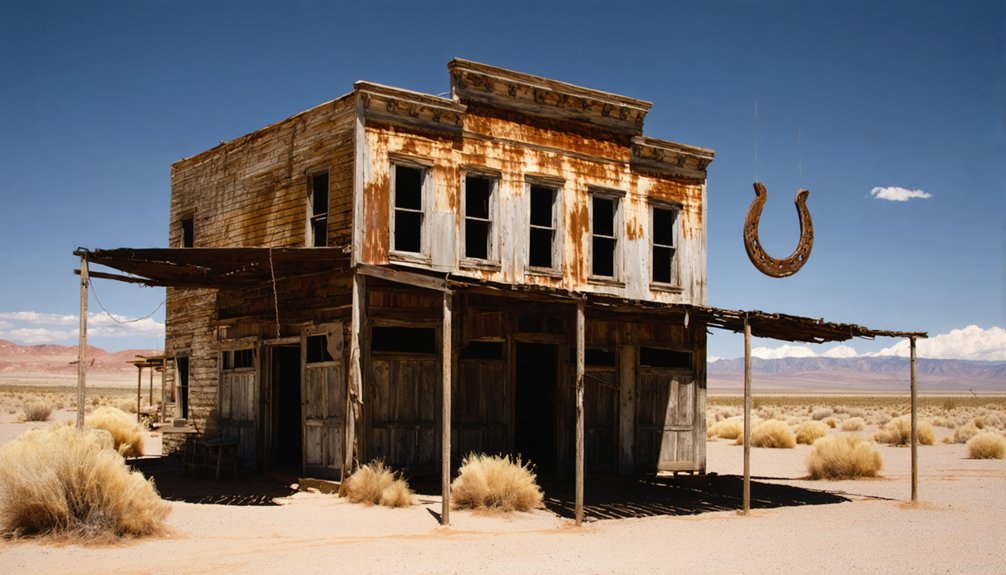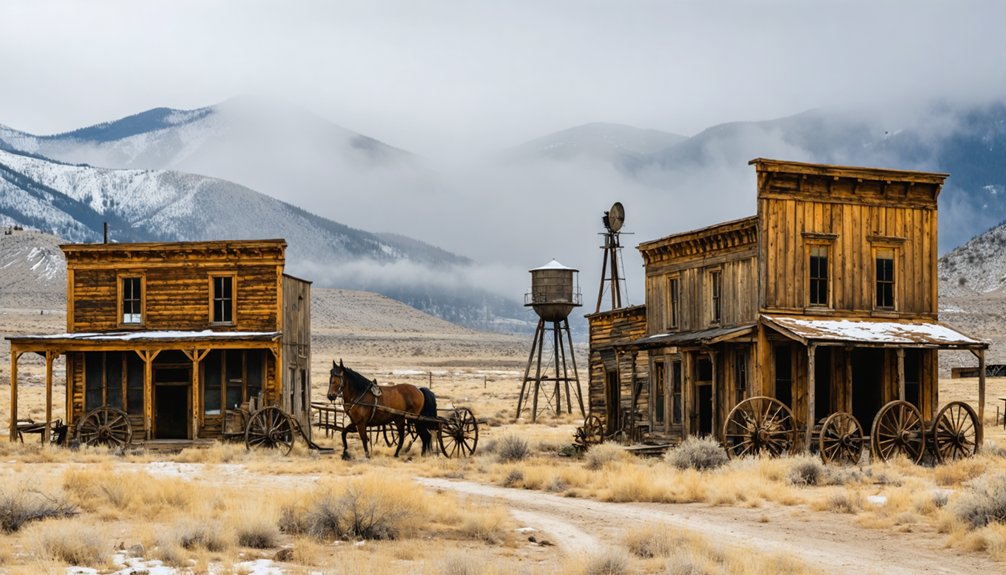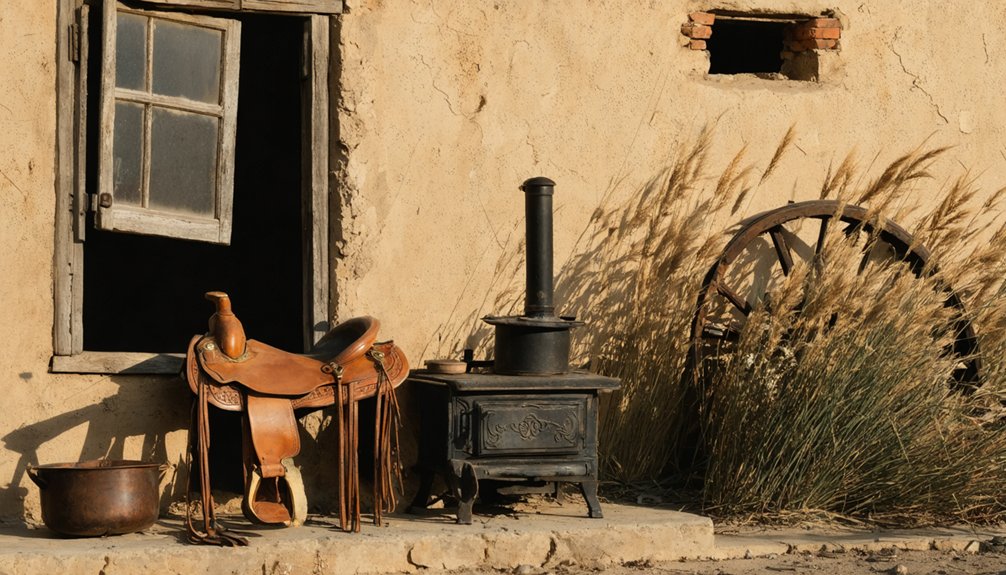America’s abandoned frontier towns stand as haunting relics of the 19th century boom-and-bust cycle. You’ll find these ghostly settlements scattered across the Western states, where gold rushes, silver strikes, and railroad expansions once fueled explosive growth. Their weathered structures tell stories of prospectors, cowboys, and pioneers who braved harsh conditions seeking fortune. When resources depleted or transportation routes shifted, these once-bustling communities emptied. Each crumbling building holds secrets of frontier life waiting to be uncovered.
Key Takeaways
- Resource depletion caused thousands of frontier towns to be abandoned after gold, silver, or timber was exhausted.
- Ghost towns like Bodie, California and Tombstone, Arizona now serve as tourist attractions showcasing authentic frontier architecture.
- The U.S. has over 1,000 documented ghost towns, with major concentrations in Texas (511), California (346), and Utah (136).
- Abandoned settlements have become symbols of America’s pioneering spirit, influencing national identity and Western mythology.
- Archaeological excavations in ghost towns reveal everyday artifacts that provide insights into frontier life and cultural interactions.
The Birth of Frontier Boomtowns (1850-1880)
While the concept of Manifest Destiny swept across America in the mid-19th century, a remarkable phenomenon began to unfold across the western frontier—the rapid emergence of boomtowns.
Following the Louisiana Purchase and government encouragement, these settlements materialized virtually overnight around mineral discoveries, particularly after the 1849 California Gold Rush.
You’d have witnessed a flurry of activity as transient populations converged from diverse backgrounds—Americans, Europeans, Chinese, and South Americans—all drawn by promises of instant wealth.
Makeshift structures quickly rose to accommodate miners wielding primitive mining technologies.
Railroad expansion determined which towns flourished and which perished, creating essential links to eastern markets and supply chains. Towns like Dodge City became prosperous due to their strategic location on the Santa Fe Railroad, which transformed them into vital hubs for cattle drives.
These volatile communities initially lacked formal institutions, embracing a spirit of freedom that often manifested as lawlessness. The General Land Office managed the distribution of public lands that settlers eagerly claimed, often with disregard for indigenous territorial rights.
Gold, Silver, and Cattle: Economic Engines of the Wild West
The economic foundations of these burgeoning frontier settlements rested on three pillars that transformed the American West into a hub of frenzied activity.
Gold discoveries like California’s Sutter’s Mill in 1848 drew over 100,000 fortune-seekers, with mining techniques evolving from simple panning to complex underground operations. When silver veins like Nevada’s Comstock Lode emerged, new rushes followed. Many of these mining camps evolved into thriving towns with hotels, stores, and other essential services.
The discovery of gleaming metals transformed barren landscapes into boomtowns overnight, drawing dreamers with promises of instant wealth.
Meanwhile, cattle drives revolutionized ranching economics. Texas cattlemen moved herds north to railheads, turning $5 investments into $50 sales in eastern markets. The open range system allowed unfettered grazing across vast public lands. These cattle drives were often led by young cowboys who worked tirelessly herding cattle across challenging terrain to railway hubs like Abilene.
The transcontinental railroad‘s completion in 1869 connected these industries to eastern buyers, accelerating growth and prosperity.
Yet this prosperity proved fragile—mining towns collapsed when deposits depleted, while overgrazing and harsh winters decimated cattle herds, leaving abandoned settlements scattered across the landscape.
Law and Disorder on the American Frontier
Beyond the romantic visions of cowboys and gold rushes, frontier settlements struggled with profound challenges in maintaining social order, creating a landscape where justice often existed more in theory than practice.
In these isolated boomtowns, you’d find sheriffs overwhelmingly outgunned and undermanned, forced to rely on citizen posses to enforce what little law existed. These posses were essential tools that originated from early English law, allowing sheriffs to deputize ordinary citizens when confronting dangerous criminals.
When you walked these dusty streets, formal law enforcement was distinctly absent—vast territories with sparse population made traditional policing nearly impossible.
Frontier justice evolved through necessity: vigilante committees and “regulators” filled the void, conducting extralegal trials and executions without due process.
As you explored these volatile communities, you’d witness the open carrying of firearms despite nominal restrictions, fueling the gunfights and saloon brawls that defined the era until railroads and permanent settlers gradually established formal legal structures.
The Downfall: Why Frontier Towns Were Abandoned
As law and order gradually took hold in frontier settlements, many of these once-thriving communities faced a paradoxical fate—they began to vanish.
The fragility of frontier economies stemmed from poor resource management and limited economic resilience, creating a perfect storm for abandonment.
You’ll find these ghost towns emerged from several critical factors:
- Resource depletion—when gold veins ran dry or forests were clear-cut, towns quickly collapsed
- Transportation shifts—new highways and railroads bypassed once-vital trade stops
- Single-industry vulnerability—company towns disappeared when mines closed or mills shut down
- Natural disasters—droughts, floods, and fires wiped communities off the map
The highly mobile frontier population embraced a “move-on” mentality, readily abandoning towns when opportunity faded elsewhere—a stark reminder of settlements built on temporary foundations.
Many of these abandoned communities were established during the frontier era, particularly throughout the 1800s when westward expansion was at its peak.
The United States contains an estimated 10,000 to 20,000 ghost towns scattered across its landscape, with the highest concentrations found in resource-rich states like California, Nevada, and Texas.
Ghost Towns Across the Western Landscape
While mapping America’s forgotten past, you’ll discover a remarkable concentration of ghost towns scattered across the Western landscape—silent monuments to boom-and-bust cycles that once defined frontier life.
Texas claims the crown with 511 documented ghost towns, followed by California (346) and Utah (136). These abandoned settlements cluster near depleted mines, defunct railroads, and forgotten trails—particularly in mountainous and arid regions where preservation challenges are naturally mitigated by dry climates.
Ghost town tourism now breathes economic life into places like Bodie, California, preserved in “arrested decay,” and Tombstone, Arizona, famous for its Wild West shootouts. Arizona features 131 ghost towns with Vulture City established as a gold-mining camp in the 1860s.
You’ll find the most accessible sites protected as state parks, offering glimpses of authentic frontier architecture, while others remain delightfully remote—perfect for explorers seeking freedom in America’s untamed historical wilderness. For interested researchers and enthusiasts, the WikiProject Ghost towns provides collaborative resources to improve Wikipedia’s coverage of ghost towns worldwide.
Daily Life in America’s Frontier Settlements
Life in America’s frontier settlements demanded extraordinary grit and adaptability from those who ventured westward in search of opportunity.
Life on the frontier tested the human spirit, forging resilience in those bold enough to chase the western horizon.
As pioneering families established roots, you’d find yourself in a community defined by isolation yet bound by necessity.
Your daily existence would revolve around:
- Self-sufficiency – producing your own food, clothing, and tools
- Simple shelters built from local materials like logs, sod, or adobe
- Social gatherings at churches, schools, and saloons that fostered community resilience
- Economic activities centered on farming, ranching, mining, or small businesses
You’d face constant challenges: scarce supplies, poor sanitation, harsh weather, and limited medical care.
Yet frontier communities demonstrated remarkable adaptability, forming fluid social hierarchies where status depended on land ownership, business acumen, or reputation rather than inherited privilege.
Innovations like John Deere’s steel plow and Cyrus McCormick’s reaper transformed frontier farming, allowing settlers to cultivate the tough prairie sod more efficiently.
Preserving the Past: Archaeological Discoveries
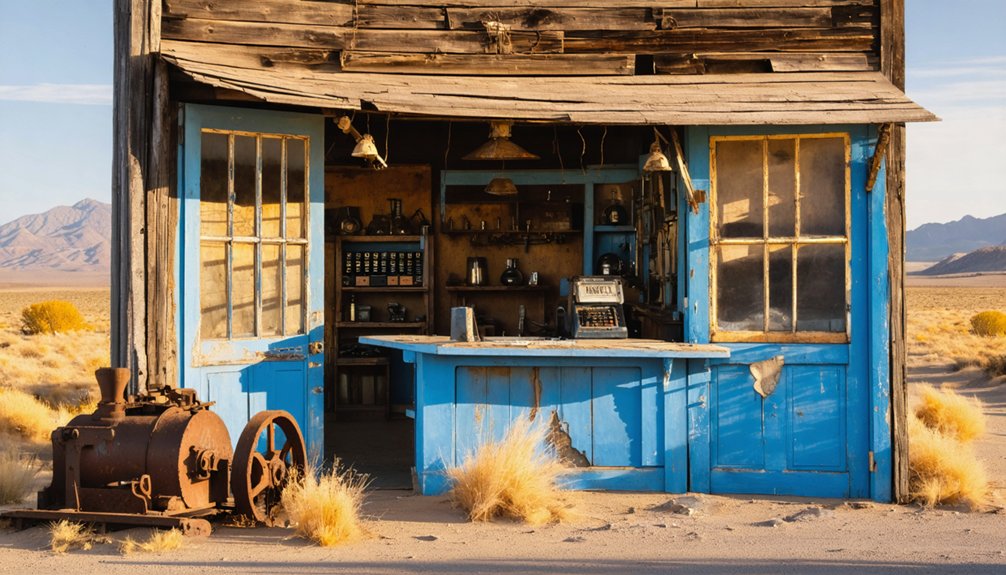
Archaeological excavations across America’s abandoned frontier towns have revealed remarkably intact everyday objects—from half-empty medicine bottles to tools dropped mid-use—that tell intimate stories of lives suddenly interrupted.
You’ll find these untouched artifacts provide unparalleled glimpses into frontier daily routines, preservation often made possible by the same economic collapse that led to abandonment.
Evidence of Indigenous-settler interactions emerges through traded goods and modified artifacts, revealing complex relationships that challenge simplistic historical narratives about frontier contact zones.
Artifact Stories Revealed
Beneath the dust and debris of America’s abandoned frontier towns, a rich tapestry of human stories awaits discovery through the artifacts left behind.
These physical remnants of frontier life illuminate community narratives often missing from written history. As you explore these forgotten places, artifact preservation becomes essential for understanding the complex social dynamics.
Daily life emerges through these silent witnesses:
- Mining implements and blacksmith tools reveal economic foundations and technological innovation
- Household items like ceramics and personal belongings reflect social status and cultural traditions
- Chinese immigrant artifacts in places like Deadwood challenge mainstream historical narratives
- Organic remains including animal bones and seeds connect human experience to environmental relationships
Each artifact tells its own story, bringing voices of everyday citizens—miners, merchants, immigrants, and families—back from obscurity.
Untouched Everyday Objects
Among the most compelling features of abandoned frontier towns are the untouched everyday objects that remain exactly where their owners left them decades ago.
You’ll find dishes still arranged on tables, tools leaning against workshop walls, and children’s toys frozen in time—forgotten belongings that tell intimate stories of daily life.
In dry climates, even fragile items like leather shoes and textile garments survive, offering unparalleled glimpses into frontier fashion and necessity.
Each artifact carries immense historical significance, revealing how residents actually lived rather than just how they were documented.
When archaeologists carefully excavate these sites, they’re recovering more than objects; they’re preserving contextual relationships between items that illuminate social networks, economic patterns, and personal choices of America’s frontier inhabitants—tangible connections to our pioneering past that modern visitors can still experience firsthand.
Indigenous-Settler Interaction Evidence
The rich tapestry of Indigenous-settler interactions emerges vividly through artifacts recovered at frontier town sites, where everyday objects tell complex stories of cultural exchange, conflict, and adaptation.
When you examine archaeological evidence from places like Little Falls and Rock Creek Park, you’ll discover patterns of intertribal trade spanning thousands of years before European arrival.
Dense artifact concentrations reveal how these frontier locations served as cultural crossroads.
- Quartzite quarry sites showing specialized tool manufacturing techniques
- Pottery sherds demonstrating knowledge transfer and cultural exchange
- Protective settlement positioning suggesting strategic responses to territorial pressures
- Resource extraction sites containing thousands of artifacts within small areas
These archaeological footprints contradict simplistic frontier narratives, instead revealing sophisticated Indigenous societies that adapted to European presence through complex negotiations of space, resources, and cultural practices.
From Bustling Streets to Empty Shells: Notable Ghost Towns
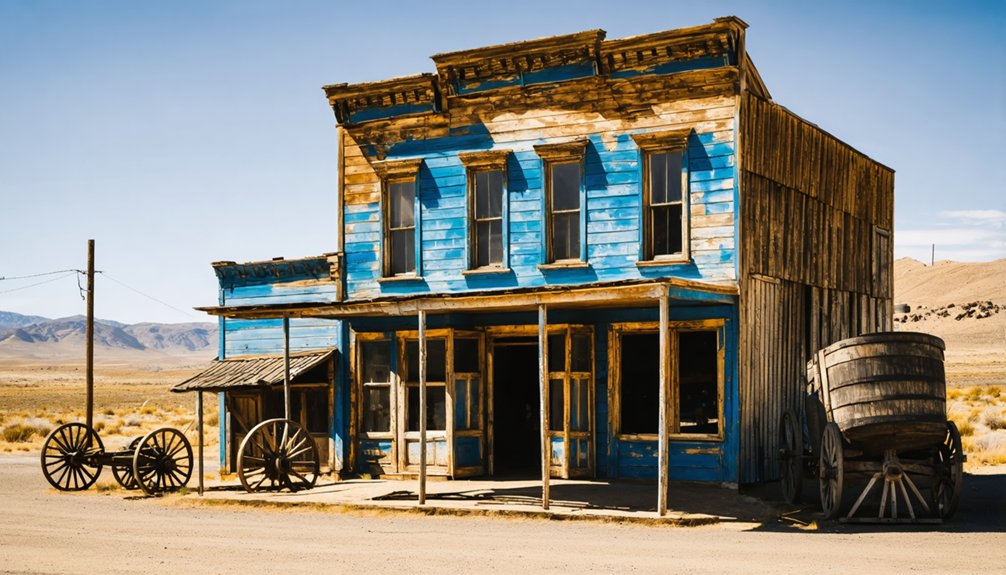
Once thriving with the dreams of thousands seeking fortune in America’s western expansion, ghost towns now stand as haunting reminders of our nation’s boom-and-bust frontier history.
These abandoned settlements echo with whispers of ambition, their empty storefronts testaments to frontier dreams both fulfilled and shattered.
You can witness this legacy in places like Bodie, California, where 110 structures remain in “arrested decay,” or Montana’s Bannack, the territory’s first capital now preserved with its weathered log buildings and wooden sidewalks.
Ghost town legends persist in St. Elmo, Colorado, considered among America’s best-preserved abandoned settlements.
Similarly, Garnet, Montana offers glimpses of 1890s mining life through its intact structures.
Even Deadwood, South Dakota—though still inhabited—preserves frontier culture through Old Trail Town’s original cabins and saloons, connecting you directly to the rugged individualism that defined these once-bustling communities.
The Cultural Legacy of Abandoned Frontier Communities
Deeply woven into America’s collective memory, abandoned frontier towns have left an indelible cultural legacy that extends far beyond their weathered buildings and empty streets.
These once-vibrant communities have shaped regional folklore and continue to influence how you understand American identity today.
When you explore these forgotten places, you’ll discover:
- Cultural narratives passed through generations, from tales of outlaws to stories of gold rush dreams
- Museums and preservation efforts that safeguard physical connections to frontier life
- Regional folklore that romanticizes the “Wild West” experience
- Educational opportunities that bring history alive through tourism and academic study
These abandoned settlements aren’t merely historical curiosities—they’re living symbols of pioneering spirit and freedom that continue to shape regional identity and national mythology.
Frequently Asked Questions
Did Children Attend Schools in Frontier Towns?
Yes, children did attend schools in frontier towns, though you’d find spotty school attendance due to chores and weather, alongside varying education quality in hastily built one-room schoolhouses.
What Happened to Cemeteries When Towns Were Abandoned?
A million stories vanished into silence as cemeteries faced overwhelming neglect. You’ll find cemetery relocation was rare—most graves remained, preserved only by nature’s embrace or destroyed by human development and harsh elements.
How Did Frontier Women Maintain Feminine Fashion Standards?
You’d adapt corset styles for practical mobility while sourcing durable fabrics like calico and linsey-woolsey. You’d save finer attire for Sundays, following fashion magazines that circulated through pioneer communities.
Were There Non-European Immigrant Communities in Frontier Towns?
Yes, you’ll find Asian immigrants built communities during the Gold Rush and railroad construction, while African settlers established towns like Nicodemus. Native Americans and Hispanic populations also shaped frontier demographics considerably.
How Did Frontier Towns Handle Waste and Sanitation?
You’d find frontier waste management appallingly primitive. Your garbage would pile on streets, while “honey wagons” emptied outhouses irregularly. Sanitation practices included dumping waste into nearby waterways, contaminating your drinking sources.
References
- https://ridewayoutwest.com/2024/09/09/rise-and-fall-of-americas-frontier-towns-from-boom-to-bust/
- https://en.wikipedia.org/wiki/Wikipedia:WikiProject_Ghost_towns
- https://www.geotab.com/ghost-towns/
- https://figshare.le.ac.uk/articles/thesis/The_Archaeology_of_Abandonment_Ghost_Towns_of_the_American_West/10120007
- https://www.resources.org/archives/survival-of-the-american-frontier/
- https://m.dresshead.com/files/scholarship/Documents/Ghost_Towns_Lost_Cities_Of_The_Old_West_Shire_Usa.pdf
- https://jasontdunn.com/files/ghost_towns_big_cities.pdf
- https://en.wikipedia.org/wiki/Ghost_town
- https://www.loveexploring.com/gallerylist/188219/the-us-state-with-the-most-ghost-towns-revealed
- https://en.wikipedia.org/wiki/Wikipedia:WikiProject_Ghost_towns/Assessment
